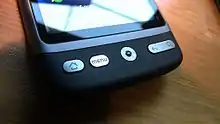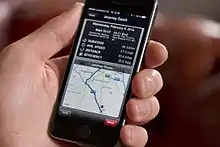Portal:Telephones
 The Telephones Portal
The Telephones Portal 

A telephone is a telecommunications device that permits two or more users to conduct a conversation when they are too far apart to be easily heard directly. A telephone converts sound, typically and most efficiently the human voice, into electronic signals that are transmitted via cables and other communication channels to another telephone which reproduces the sound to the receiving user. The term is derived from Greek: τῆλε (tēle, far) and φωνή (phōnē, voice), together meaning distant voice. A common short form of the term is phone, which came into use early in the telephone's history.
In 1876, Alexander Graham Bell was the first to be granted a United States patent for a device that produced clearly intelligible replication of the human voice at a second device. This instrument was further developed by many others, and became rapidly indispensable in business, government, and in households. (Full article...)
A mobile phone (cellphone, etc.) is a portable telephone that can make and receive calls over a radio frequency link while the user is moving within a telephone service area, as opposed to a fixed-location phone (landline phone). The radio frequency link establishes a connection to the switching systems of a mobile phone operator, which provides access to the public switched telephone network (PSTN). Modern mobile telephone services use a cellular network architecture and therefore mobile telephones are called cellphones (or "cell phones") in North America. In addition to telephony, digital mobile phones support a variety of other services, such as text messaging, multimedia messagIng, email, Internet access (via LTE, 5G NR or Wi-Fi), short-range wireless communications (infrared, Bluetooth), satellite access (navigation, messaging connectivity), business applications, video games and digital photography. Mobile phones offering only basic capabilities are known as feature phones; mobile phones which offer greatly advanced computing capabilities are referred to as smartphones. (Full article...)
A smartphone is a portable computer device that combines mobile telephone functions and computing functions into one unit. They are distinguished from older-design feature phones by their stronger hardware capabilities and extensive mobile operating systems, which facilitate wider software, access to the internet (including web browsing over mobile broadband), and multimedia functionality (including music, video, cameras, and gaming), alongside core phone functions such as voice calls and text messaging. Smartphones typically contain a number of metal–oxide–semiconductor (MOS) integrated circuit (IC) chips, include various sensors that can be leveraged by pre-installed and third-party software (such as a magnetometer, a proximity sensor, a barometer, a gyroscope, an accelerometer, and more), and support wireless communication protocols (such as Bluetooth, Wi-Fi, or satellite navigation). More recently, smartphone manufacturers have begun to integrate satellite messaging connectivity and satellite emergency services into devices for use in remote regions where there is no reliable cellular network. (Full article...)
Selected article -
The National Do Not Call Registry is a database maintained by the United States federal government, listing the telephone numbers of individuals and families who have requested that telemarketers not contact them. Certain callers are required by federal law to respect this request. Separate laws and regulations apply to robocalls in the United States.
The Federal Trade Commission (FTC) opened the National Do Not Call Registry in order to comply with the Do-Not-Call Implementation Act of 2003 (Pub. L. 108–10 (text) (PDF), was H.R. 395, and codified at 15 U.S.C. § 6101 et seq.), sponsored by Representatives Billy Tauzin and John Dingell and signed into law by President George W. Bush on March 11, 2003. The law established the FTC's National Do Not Call Registry in order to facilitate compliance with the Telephone Consumer Protection Act of 1991. A guide by FTC addresses a number of cases.
Registration for the Do-Not-Call list began on June 27, 2003, and enforcement started on October 1, 2003. Since January 1, 2005, telemarketers covered by the registry have up to 31 days (initially the period was 90 days) from the date a number is registered to cease calling that number. Originally, phone numbers remained on the registry for a period of five years, but are now permanent because of the Do-Not-Call Improvement Act of 2007, effective February 2008. (Full article...)Types of phones -

Mobile radio telephone systems were mobile telephony systems that preceded modern cellular network technology. Since they were the predecessors of the first generation of cellular telephones, these systems are sometimes retroactively referred to as pre-cellular (or sometimes zero generation, that is, 0G) systems. Technologies used in pre-cellular systems included the Push to Talk (PTT or manual), Mobile Telephone Service (MTS), Improved Mobile Telephone Service (IMTS), and Advanced Mobile Telephone System (AMTS) systems. These early mobile telephone systems can be distinguished from earlier closed radiotelephone systems in that they were available as a commercial service that was part of the public switched telephone network, with their own telephone numbers, rather than part of a closed network such as a police radio or taxi dispatching system.
These mobile telephones were usually mounted in cars or trucks (thus called car phones), although portable briefcase models were also made. Typically, the transceiver (transmitter-receiver) was mounted in the vehicle trunk and attached to the "head" (dial, display, and handset) mounted near the driver seat.
They were sold through WCCs (Wireline Common Carriers, a.k.a. telephone companies), RCCs (Radio Common Carriers), and two-way radio dealers. (Full article...)Selected audio -
Last-call return, automatic recall, or (on PBX and centrex service) camp-on, is a telecommunication feature offered by telephony service providers to subscribers to provide the subscriber with the telephone number, and sometimes the time, of the last caller. The service may also offer the facility to place a call to the calling party. (Full article...)
List articles
- Comparison of smartphones
- List of best-selling mobile phones
- List of countries by number of broadband Internet subscriptions
- List of countries by number of telephone lines in use
- List of countries by smartphone penetration
- List of country calling codes
- List of iPhone models
- List of mobile network operators
- List of mobile phone brands by country
- List of mobile phone generations
- List of telephone operating companies
Related portals
General images -
Selected biography
Selected images
Topics
Subcategories
More
 |
Here are some tasks awaiting attention:
|
![]() WikiProject Telecommunications
WikiProject Telecommunications
![]() Bell System task force
Bell System task force
Telephones in the news
- 23 April 2023 –
- The United Kingdom launches its UK Emergency Alert System, sending a test emergency population warning to all 4G and 5G mobile phones for the first time. Many people do not receive the alert, particularly users of the Three mobile network. The Cabinet Office acknowledges that the emergency alert did not reach some people, saying that it is "reviewing the test". (BBC News)
Associated Wikimedia
The following Wikimedia Foundation sister projects provide more on this subject:
-
 Commons
Commons
Free media repository -
 Wikibooks
Wikibooks
Free textbooks and manuals -
 Wikidata
Wikidata
Free knowledge base -
 Wikinews
Wikinews
Free-content news -
 Wikiquote
Wikiquote
Collection of quotations -
 Wikisource
Wikisource
Free-content library -
 Wikiversity
Wikiversity
Free learning tools -
 Wiktionary
Wiktionary
Dictionary and thesaurus
-
 List of all portalsList of all portals
List of all portalsList of all portals -
 The arts portal
The arts portal -
 Biography portal
Biography portal -
 Current events portal
Current events portal -
 Geography portal
Geography portal -
 History portal
History portal -
 Mathematics portal
Mathematics portal -
 Science portal
Science portal -
 Society portal
Society portal -
 Technology portal
Technology portal -
 Random portalRandom portal
Random portalRandom portal -
 WikiProject PortalsWikiProject Portals
WikiProject PortalsWikiProject Portals















.jpg.webp)
.jpg.webp)











.jpg.webp)







.jpg.webp)

















.svg.png.webp)

































